Ultrabook Head to Head: Acer Aspire S3 vs. ASUS UX31E
by Jarred Walton & Manveer Wasson on December 21, 2011 5:40 AM ESTNetbook Levels of Battery Life
When netbooks came on the scene, they made the idea of a $1000+ ultraportable seem rather laughable. Several years later we’re rebranding ultraportables as ultrabooks (provided they have Intel Inside) and giving it another go. Of course, ultrabooks pack a few tricks like SSDs for better battery life and performance, and Intel’s ULV Sandy Bridge processors are proving to be very efficient when it comes to saving power. We ran our usual suite of battery life tests, with the LCDs set to as close to 100 nits as possible (50% brightness on the Acer S3 and 18% brightness on the ASUS UX31E).
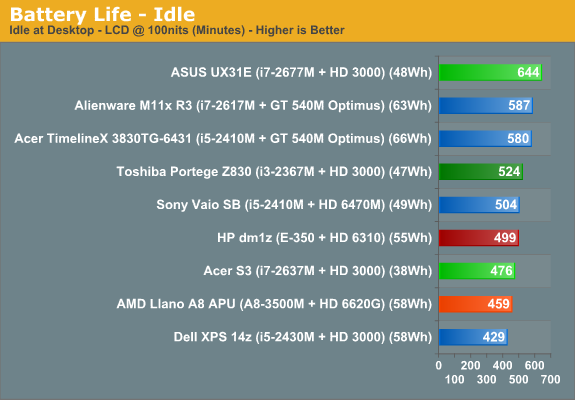
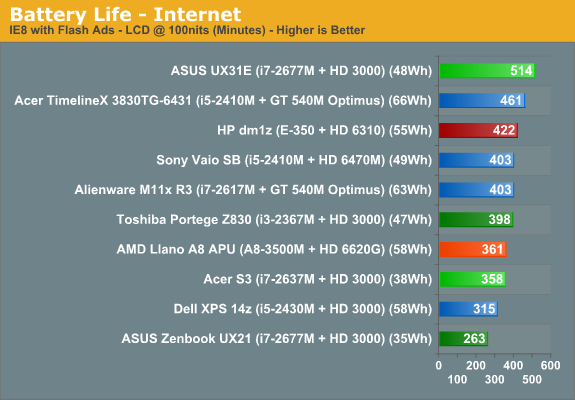
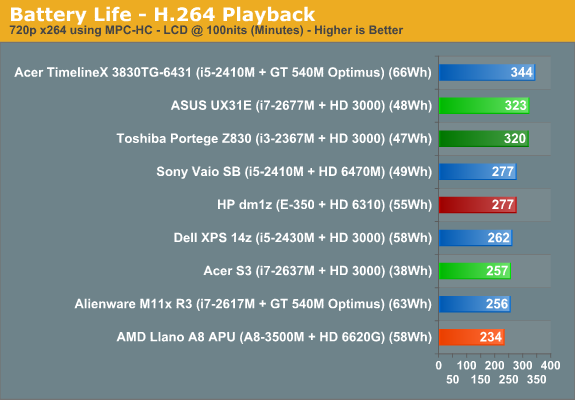
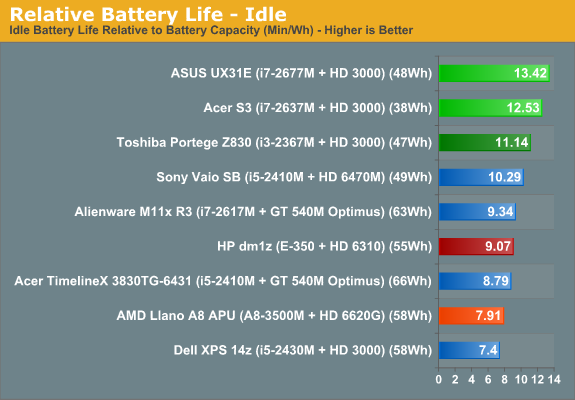
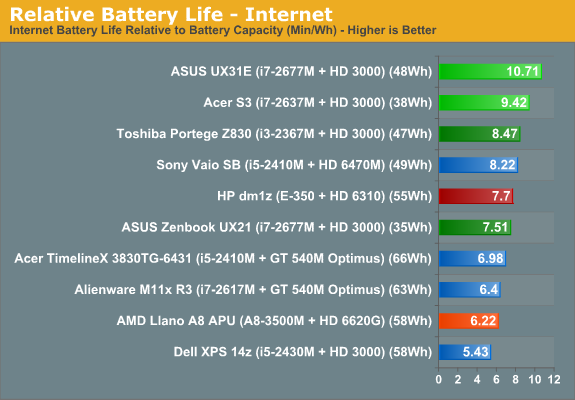

The Acer has a much smaller 3-cell battery, but even with a 38Wh capacity it still boasts respectable battery life of over four hours of H.264 playback and nearly eight hours of idle time. Switch over to the UX31E and not only do you get a higher battery capacity, you also get apparently better power optimizations. In our H.264 test the ASUS “only” manages close to 5.5 hours of playback, while it jumps to 8.5 hours of Internet surfing and over 10.5 hours of idle time. Look at the relative battery life charts and the results are even more impressive: the three ultrabooks we’ve reviewed place at the top of the charts, and even if we compare with Atom, the UX31E matches and sometimes exceeds what the best netbooks could achieve; the other two ultrabooks where we’ve done full reviews also place near the top of our relative battery life charts.
Something else we tested that we don’t have in the above charts is idle battery life with the LCD at maximum brightness. The Acer drops to 400 minutes, but then it only gets about 120% brighter as we’ll see on the next page. The UX31E on the other hand does a swan dive down to just 357 minutes, but you have to take into consideration the 450% increase in brightness. Put another way, power draw for the Acer is around 4.7W at 107 nits (50%) and 5.59W at 234 nits (100%); the ASUS on the other hand uses 4.38W at 93 nits (18%) and jumps up to 7.91W at 519 nits (100%). Even though that’s a pretty big jump in power use, we still have to credit the LED backlighting technology: 500+ nits for less than 5W of power isn’t really that bad.
The short summary here is that you may have to pay more, but you do get substantially better performance than a netbook, you don’t sacrifice much in the size or battery life departments, and build quality is generally far higher than inexpensive laptops and netbooks. Does that make ultrabooks a better option than other laptops? Not for everyone, but there are certainly people that will like what ultrabooks have to offer.










81 Comments
View All Comments
JarredWalton - Thursday, December 22, 2011 - link
At 100 nits the UX31E has a white point of 93.39 and a black point of 0.44, giving a contrast of 212:1 -- basically it doesn't change.cobalt42 - Wednesday, December 21, 2011 - link
Thanks for the review.I just wanted to say I appreciate that you show a nice, direct picture of the keyboard layout and include some discussion of dedicated home/end/pageup/pagedown/insert/delete keys. That's the main thing keeping me away from MBAs, and these two don't get it quite right either. (Yes, I use those keys constantly. Chording is not acceptable when there's plenty of space on the keyboard for dedicated keys. And is that a power button KEY on the Asus? How often do you need to hit the power button that you need to waste an entire key for it? Insane.) The Toshiba Z830 has a good key layout, but too many other things wrong with it like the ridiculously low resolution.
tim851 - Friday, December 30, 2011 - link
I HATE it, when they place a dedicated row of Home/End/... buttons next to the keyboard. I tend to hit the Delete and Enter keys on the right edge and if that row is present, I will oftentimes hit one of its keys alongside the one I mesnt to press.That's why I find I have little choice when it comes to 13" laptops, because most of them have that dreaded row of keys.
Please, leave the few that don't, alone!
ccd1 - Wednesday, December 21, 2011 - link
Santa brought me an early Christmas gift of the Dell 15z. Santa had read the review here and ordered the 15z with only two upgrades, the 1080 display and a 256k SSD. Based on my brief use of this PC, I have these thoughts.Ultrabooks have the potential to expand portability to include larger machines. True portability stops at 14" right now, IMHO. It would be really nice to see a 15" ultrabook. The 15z kind of gets there, but not quite. A thinner, lighter 15z would definitely be more portable.
All of these machines need a really good docking station, ideally a combo laptop cooler and docking station. To have these machines double as desktops, would want one plug for the peripherals and be done with it. Right now I have my machine connected to a big display, keyboard, mouse, laptop cooler, mic, and HDD backup. The idea of plugging and unplugging all these peripherals to move the machine around is a real damper on portability. Love to have a docking station that plugs into the USB 3.0 port and be done with it.
r3loaded - Wednesday, December 21, 2011 - link
It's funny to note that the Asus Transformer Prime (practically the stylistic tablet equivalent of the Zenbook) has a far superior display compared to these ultrabooks that cost more than double. I hope Apple can push the industry forward instead of letting them race to the bottom on displays.ibtar - Wednesday, December 21, 2011 - link
Pretty sure we've already hit rock bottom as far as LCD quality goes, at least in laptops. Only place to go from here is up, but who knows when that'll happen.Death666Angel - Wednesday, December 21, 2011 - link
Coming from a Travelmate 8172, my next notebook needs to look similar to:- 2 core CPU between 1.5 and 2.5GHz (4 threads optional)
- integrated GPU to play HL2-ish titles at native resolution and medium settings
- 128GB SSD (performance on par with first SF-Generation or better) (mSATA SSD + 2.5" HDD optimum)
- 4 GB RAM (8 GB optional)
- matte 12.1" to 13.3" LCD with 1600x900 (good brightness appreciated, contrast and color replication secondary)
- weight below 1.5kg
- thickness anything under 3cm, length and width as the display allows plus medium bezel
- no ODD
- trackpad area separated from rest of the chassis, keyboard keys as big as possible for the chassis
- 60Wh battery fully replaceable by the end user
- Intel WLAN adapter with 300+Mb/s, 2.4GHz/5GHz dualband (3G not needed)
- 2xUSB 3.0, 2xUSB 2.0, 1 Gb Ethernet and/or Thunderbolt
Price can be between 800€-1200€, depending on actual components.
What I will not buy anymore: 1366x768 in anything above 11.6", glossy LCD, anything without either USB 3.0 or Thunderbolt.
Snotling - Wednesday, December 21, 2011 - link
not ever again (unless its a smart phnoe)retrospooty - Wednesday, December 21, 2011 - link
"NOT going under 900p"Ditto.
Any product at all when I see 1368x768 I immediately tune out. So tired of that low res as a standard.
One good thing you gotta give Apple, is the retina display. To me its overkill for a phone, but if it can help to usher in the end of 1368x768 laptops then I applaud them. Thank you Apple!
nphewitt - Wednesday, December 21, 2011 - link
Apple uses MagSafe connectors, not MagLock. Kleenex vs Tissue, whatever. Just putting it out there.